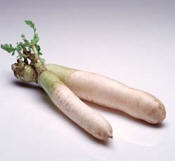Meaning of daikon

Daikon (Japanese: 大根, literally "large root"; Traditional Chinese: 白蘿蔔, literally bai2-luo2-bo5 "white radish"; In the Chaozhou dialect of Min Nan it is called beh-cai-tao (白菜頭) white vegetable head cf with carrots which is called ang-cai-tao (紅菜頭) red vegetable head, Korean: 무 mu, literally "radish"), is a mild-flavored East Asian giant white radish. Though most widely known as daikon, the radish is also known under other names, including daikon radish, Japanese or Chinese radish, winter radish, mooli or moo (Korean), lobak, loh bak, lo-bok, or lo bok (Cantonese), labanos, rabu, phakkat-hua, and củ cải trang (Vietnamese).[1] Although there are many varieties of daikon, the most common in Japan, the Aokubi Daikon, has the shape of a giant carrot, approximately 20 to 35 cm (8 to 14 inches) long and 5 to 10 cm (2 to 4 inches) in diameter. One of the most unlikely shaped daikon is Sakurajima daikon from Kagoshima Prefecture that is shaped like an oversized turnip with white outside and bright pink inside.
-from Wiki
Advertisement
